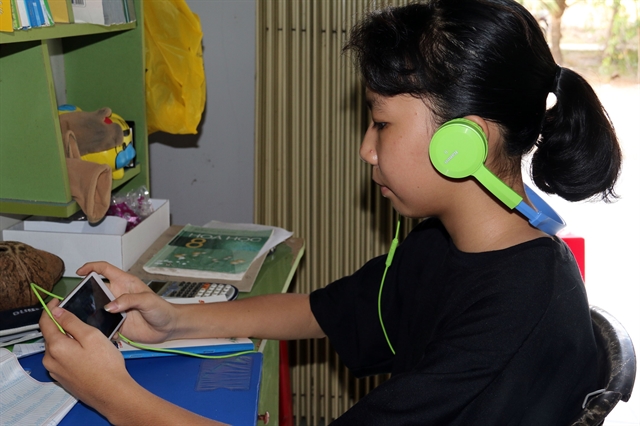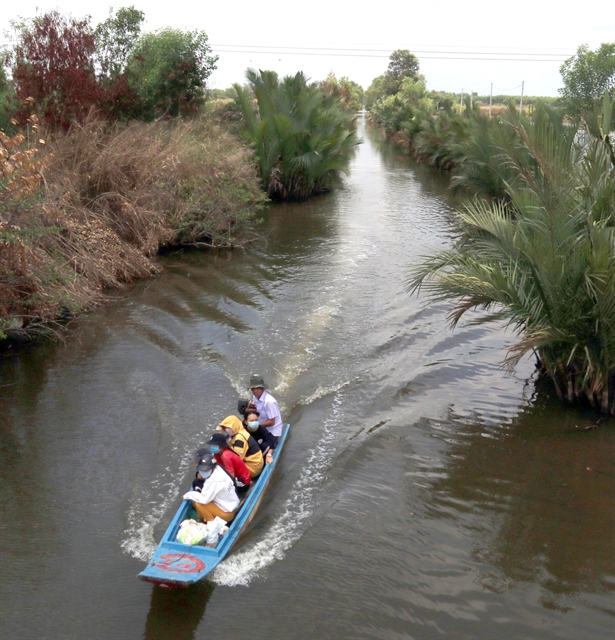 Society
Society


|
| A student from Cán Gáo Village in the southern province of Kiên Giang’s An Minh District takes an online lesson. — VNA/VNS Photo Lê Sen |
KIÊN GIANG — Every day, Trần Thị Vân from Cán Gáo Village in the southern province of Kiên Giang’s An Minh District gets up early to prepare food and then take her son to school by boat.
She often waits until the class finishes and then takes him back as it takes her several hours to carry her son – a second grader – to school and back.
Many students and parents can share similar stories because it's not easy for them to get to the school, which is more than 9km from their homes.
Ngô Thị Diệu, another resident, said she would normally ask her neighbours for help but she preferred to take her children to school every day.
“Children are naughty so I feel insecure leaving them with others,” she said.
Nguyễn Thành Công, secretary of Càn Gáo Village's Party Commitee, said although the number of poor households had fallen gradually over the past few years, the journey to the school had not been getting any easier.
Students are often carried to school by boats, particularly those from subzone 34.
For decades, people here had been dreaming of a concrete road to make it safer for students, he said, adding that there were over 100 children of a school-age living in the subzone.
For second graders, their parents take them to a paved road so they can ride on their bicycles to finish the final 3-5km distance to school.
Công said the problem was why only four students in the area had been accepted to study at college.
Ngô Thanh Đảm, head of Đông Hưng B Commune’s Study Promotion Association, said the association always gave priority to students from Cán Gáo Village, while presenting notebooks or gifts for disadvantaged children, adding that most of their families suffered financial difficulties.
According to Công, Cán Gao is home to 404 households with 1,660 villagers. Of these, 18 are poor and 28 are near-poor households.

|
| Students from Cán Gáo Village in the southern province of Kiên Giang’s An Minh District are ferried to school by boat. — VNA/VNS Photo Lê Sen |
Schooling has become worse since they had to switch online learning due to the impacts of the COVID-19 pandemic.
With no broadband in the area, this posed more problems.
Most of them had to go to their relatives or buy computers, as well as buy 4G sim cards to access the internet, he said.
“It is quite a burden for the families who can barely make ends meet,” Công said.
Huỳnh Kim Khánh, an eighth-grader from Đông Hưng B Secondary School, said her parents had bought a smartphone and registered for 4G internet data for VNĐ120,000 (US$5) per month. However, the internet connection was unstable, adding that she had to stay at her grandmother’s house to make it convenient.
Huỳnh Bảo Trân, a second-year student from Tây Đô University, said to facilitate her studies, her parents had to borrow money to buy a laptop worth over VNĐ17 million ($720).
Trần Thị Anh Thư, another student from Kiên Giang University, said she was worried about her studies.
“Due to the lack of internet connection, I’ve purchased a 4G sim but it’s not good enough for me to learn online,” she said.
Thư said she hoped that an internet connection would be available in the locality soon.
Her desire was shared by Công, who said it would not only enable students to continue their studies but also help local residents access valuable information which they could apply in production. — VNS




